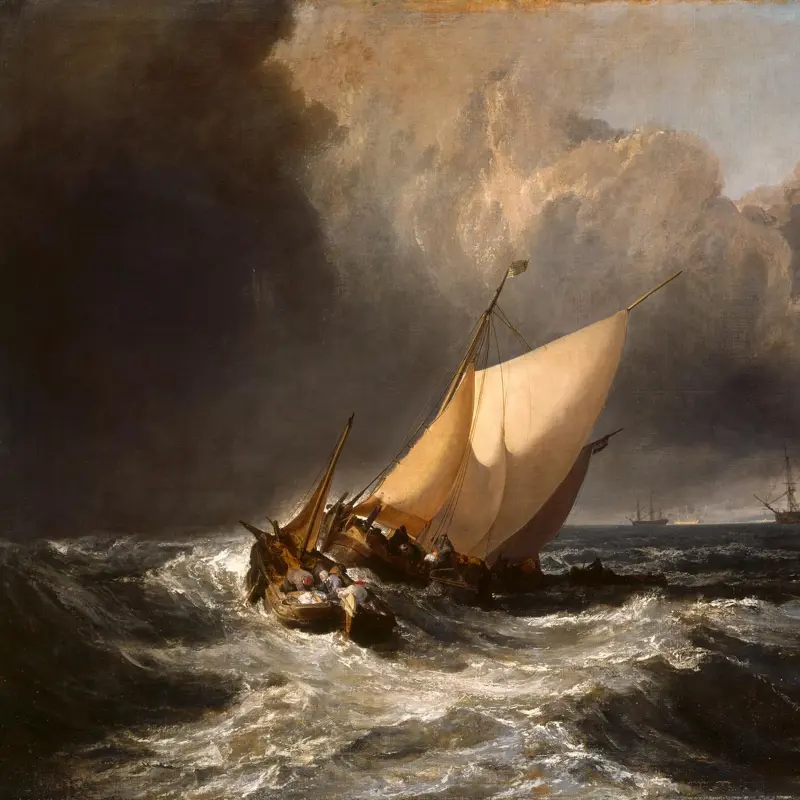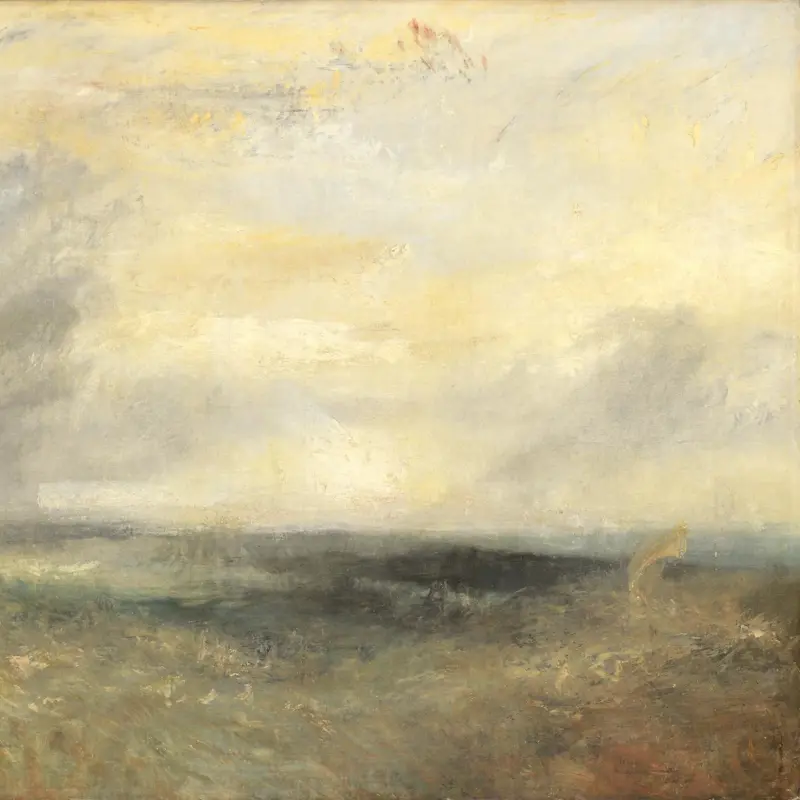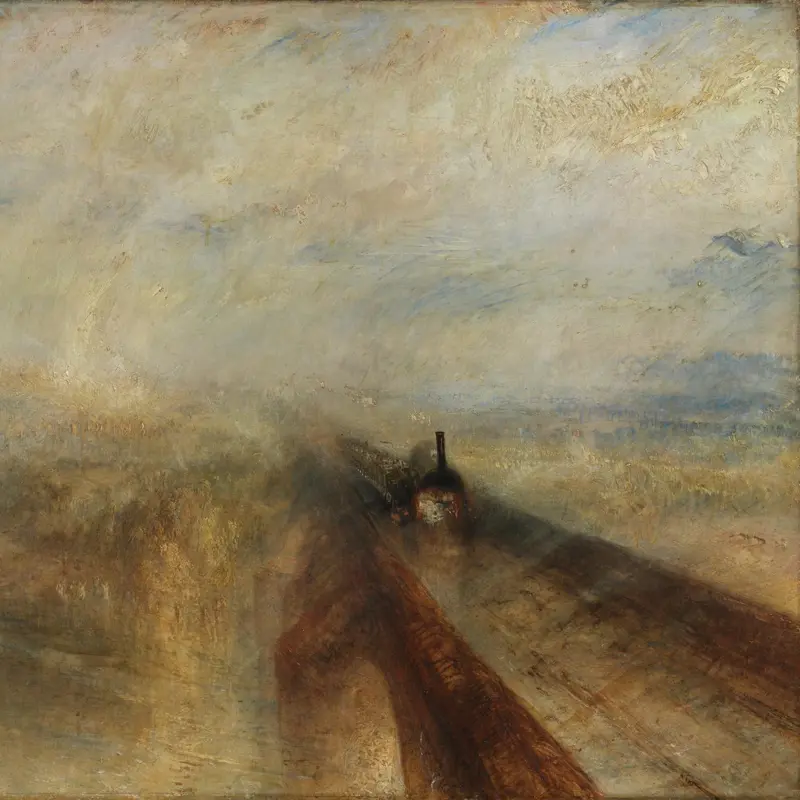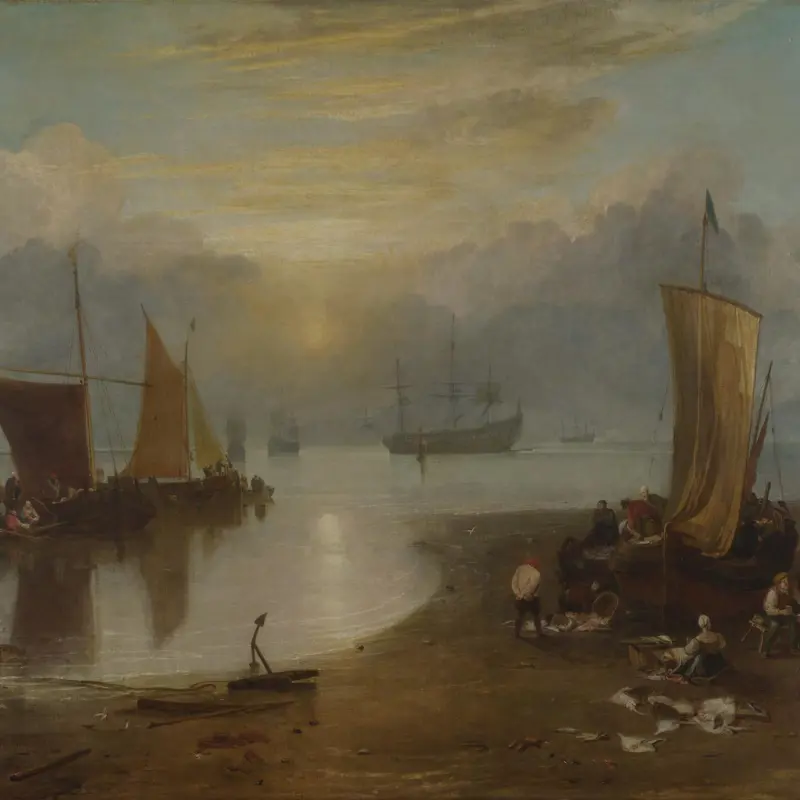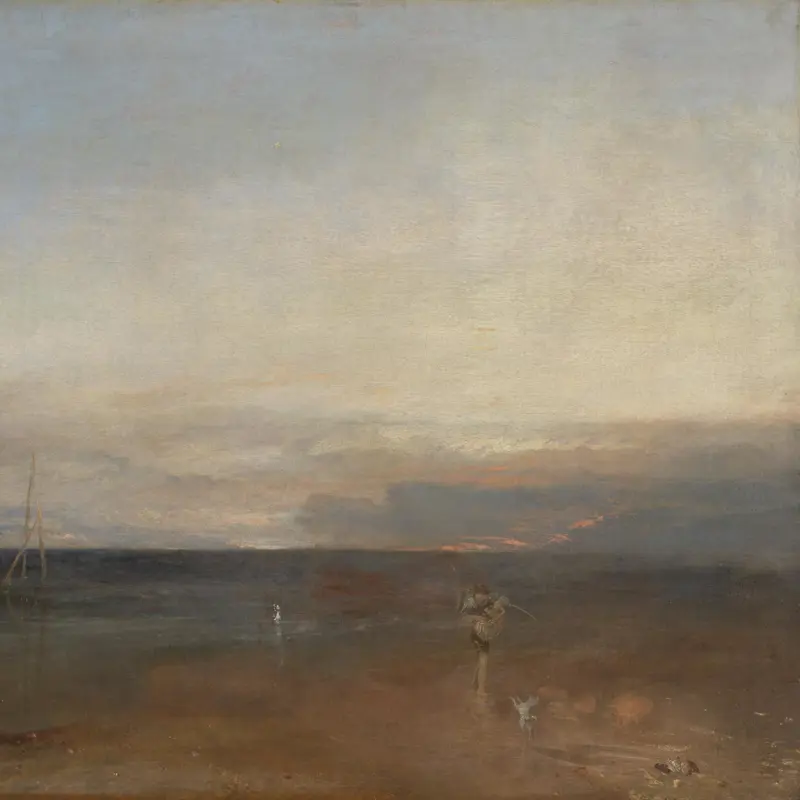Joseph Mallord William Turner, 'The Parting of Hero and Leander', before 1837
About the work
Overview
This picture illustrates an ancient Greek myth that was retold by later writers, including the English romantic poet, Lord Byron. Hero, a priestess of Aphrodite, lived in a tower on the Hellespont strait, which separates Europe from Asia. She was in love with Leander, a young man from the Asian side. Every night she would hold up a lamp to guide him as he swam through the water to be with her. One night the lamp blew out, and he was drowned. Hero threw herself off her tower to join him in death.
Turner breaks with the conventions of history painting, which required the principal characters be in or near the centre of the picture, almost hiding the doomed couple in shadow at the water’s edge as Leander prepares to leave. Above them on the terrace, a winged Cupid holds up a lamp and a torch. Turner constructs an exotic location of classical architecture and large, jagged rocks set against a turbulent night sky.
Key facts
Details
- Full title
- The Parting of Hero and Leander - from the Greek of Musaeus
- Artist dates
- 1775 - 1851
- Date made
- Before 1837
- Medium and support
- Oil on canvas
- Dimensions
- 146 × 236 cm
- Acquisition credit
- Turner Bequest, 1856
- Inventory number
- NG521
- Location
- Room 36
- Collection
- Main Collection
- Previous owners
Provenance
Additional information
Text extracted from the ‘Provenance’ section of the catalogue entry in Judy Egerton, ‘National Gallery Catalogues: The British Paintings’, London 2000; for further information, see the full catalogue entry.
Exhibition history
-
2009Long Loan to Tate (2009 - 2019) (Tate Exchange Loans)Tate Gallery (London)25 March 2009 - 24 March 2019
-
2011Turner Monet Twombly: Later PaintingsTate Liverpool22 June 2012 - 28 October 2012
-
2014Late Turner: Painting Set FreeTate Britain10 September 2014 - 25 January 2015
-
2023Masterpieces from the National GalleryShanghai Art Museum East17 January 2023 - 7 May 2023National Museum of Korea2 June 2023 - 9 October 2023Hong Kong Palace Museum22 November 2023 - 11 April 2024Chimei Museum2 May 2024 - 1 September 2024
Bibliography
-
1857R.N. Wornum, Descriptive and Historical Catalogue of the Pictures in the National Gallery, with Biographical Notices of the Painters: British School, London 1857
-
1899W. Smith (ed.), Dictionary of Greek and Roman Biography and Mythology, London 1899
-
1903J. Ruskin, Modern Painters, eds E.T. Cook and A. Wedderburn, The Works of John Ruskin, 39 vols, London 1903
-
1908W.G. Rawlinson, The Engraved Works of J.M.W. Turner, 2 vols, London 1908
-
1923H.S. Mitford, Poetical Works of Leigh Hunt, Oxford 1923
-
1946M. Davies, Paintings and Drawings on the Backs of National Gallery Pictures, London 1946
-
1961A.J. Finberg and H.F. Finberg, The Life of J.M.W. Turner, R.A., 2nd revised edn, Oxford 1961
-
1969J. Gage, Colour in Turner: Poetry and Truth, London 1969
-
1970F. Page and J. Jump, Byron, the Poetical Works, Oxford 1970
-
1971M. Allott, The Poems of John Keats, London 1971
-
1974J.P. Mouilleseaux, '"Léandre et Héro" de Taillasson: A propos d'un thème iconographique et littéraire', Revue du Louvre, XXIV/6, 1974
-
1977K.D. Nicholson, J.M.W. Turner's Images of Antiquity, Phd Thesis, University of Pennslyvania 1977
-
1981W. Gaunt, Turner, Oxford 1981
-
1981J. Gage, 'Turner and the Greek Spirit', Turner Studies, I/2, 1981, pp. 14-23
-
1982M. Butlin and E. Joll, L'opera completa di Turner 1793-1829, Milan 1982
-
1984M. Butlin and E. Joll, The Paintings of J.M.W. Turner, R.A., New Haven 1984
-
1987C. Ricks (ed.), The Poems of Tennyson, London 1987
-
1988K. Nicholson, 'Style as Meaning: Turner's Late Mythological Landscapes', Turner Studies, II/2, 1988, pp. 45-54
-
1989A. Wilton, 'J.M.W. Turner: The Parting of Hero and Leander', Apollo, CXXXIX, 1989, pp. 46-7
-
1990K.D. Nicholson, Turner's Classical Landscapes: Myth and Meaning, Princeton 1990
-
1990E. Shanes, Turner's Human Landscape, London 1990
-
1992D.B. Brown, Turner and Byron (exh. cat. Tate Gallery, 3 June - 20 September 1992), London 1992
-
1993J. Piggott, Turner's Vignettes (exh. cat. Tate Gallery, 29 September 1993 - 13 February 1994), London 1993
-
1994A. Thomas, An Illustrated Dictionary of Narrative Painting, London 1994
-
1997J. Hamilton, Turner: A Life, London 1997
-
1997M.D. Rincón de Arellano, 'Turner visto por sus contemporáneos', Goya, 256, 1997, pp. 235-40
-
1998J. Egerton, The British School, London 1998
-
2000Egerton, Judy, National Gallery Catalogues: The British Paintings, revised edn, London 2000
-
2001
C. Baker and T. Henry, The National Gallery: Complete Illustrated Catalogue, London 2001
About this record
If you know more about this work or have spotted an error, please contact us. Please note that exhibition histories are listed from 2009 onwards. Bibliographies may not be complete; more comprehensive information is available in the National Gallery Library.



